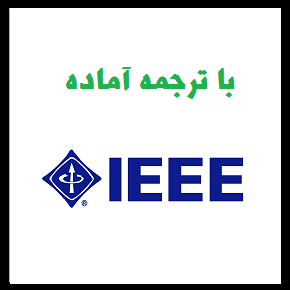دانلود رایگان مقاله تشخیص سریع اسپمر ها از طریق اشتراک اطلاعات مشارکتی – سال 2019


مشخصات مقاله:
عنوان فارسی مقاله:
تشخیص سریع اسپمر ها از طریق اشتراک اطلاعات مشارکتی در میان فراهم کنندگان خدمات چندگانه
عنوان انگلیسی مقاله:
Rapid detection of spammers through collaborative information sharing across multiple service providers
کلمات کلیدی مقاله:
SPIT، مشارکتی، VoIP، عملیات شبکه، اعتبار
مناسب برای رشته های دانشگاهی زیر:
مهندسی کامپیوتر – مهندسی فناوری اطلاعات – مهندسی فناوری اطلاعات و ارتباطات
مناسب برای گرایش های دانشگاهی زیر:
الگوریتم و محاسبات – اینترنت و شبکه های گسترده – شبکه های کامپیوتری
وضعیت مقاله انگلیسی و ترجمه:
مقاله انگلیسی را میتوانید به صورت رایگان با فرمت PDF با کلیک بر روی دکمه آبی، دانلود نمایید. برای ثبت سفارش ترجمه نیز روی دکلمه قرمز رنگ کلیک نمایید. سفارش ترجمه نیازمند زمان بوده و ترجمه این مقاله آماده نمیباشد و پس از اتمام ترجمه، فایل ورد تایپ شده قابل دانلود خواهد بود.
فهرست مطالب:
Outline
Highlights
Abstract
Keywords
۱٫ Introduction
۲٫ VoIP spam
۳٫ Related work and motivation
۴٫ Collaborative SPIT detection system: the design
۵٫ Discussion on the privacy protection
۶٫ Experimental methodology
۷٫ Performance evaluation
۸٫ Conclusions
Acknowledgments
References
قسمتی از مقاله انگلیسی:
Abstract
Spammers and telemarketers target a very large number of recipients usually dispersed across many Service Providers (SPs). Collaboration and Information sharing between SPs would increase the detection accuracy but detection effectiveness depends on the amount of information shared between SPs. Having service provider’s exchange call detail records would arguably attain the best detection accuracy but would require significant network resources. Moreover, SPs are likely to feel uncomfortable in sharing their call records because call records contain user’s private information as well as operational details of their networks. The challenge towards the design of collaborative Spam over Internet Telephony (SPIT) detection system is two-fold: it should attain high detection accuracy with a small false positive, and should fully protect the privacy of users and their service providers. In this paper, we propose a COllaborative Spit Detection System (COSDS)—a collaborative SPIT detection system for the Voice over IP (VoIP) network where service providers collaborate for the effective and early detection of SPIT callers without raising privacy concerns. To this extent, COSDS relies on a trusted Centralized Repository (CR) and exchange of non-sensitive reputation scores. The CR computes global reputation of users by aggregating the reputation scores provided by the respective collaborating SPs. The data exchanged to the CR is not sensitive regarding users privacy, and cannot be used to infer the relationship network of users. We evaluate the performance of our system using synthetic data that we have generated by simulating the realistic social behavior of spammers and non-spammers in a network. The results show that the COSDS approach has better detection accuracy as compared to the traditional stand-alone detection systems. For instances, in a setup where spammers are making calls to recipients of many SPs, COSDS successfully identifies spammers with the True Positive (TP) rate of around 80% and false positive (FP) rate of around 2% on a first day, which further increases to 100% TP rate and zero FP rate in three days. COSDS approach is fast, requires a small communication overhead, ensures privacy of users and collaborating SP, and requires only few iterations for the reputation convergence within the SP.
1. Introduction
For many years, E-mail and other online networks (social networks, websites, blogs) have been widely used by scammers to target users with the unwanted content (advertisements, malware etc.). The trend has been changed from the last few years, because of cheap telephony and its larger customers base, telephone call has become the preferred method used by fraudsters to distribute the unsolicited and advertisement content [1]. Unwanted communication in telephony is more annoying than the traditional email or text spamming as it requires an immediate response from the call recipient. Moreover, unwanted pre-recorded messages unnecessarily overwhelm the voice mail-box with the lengthy unwanted speech stream, that later requires a considerable amount of time to clean it [2]. Apart from annoyance, these calls can cause financial loss to the telephony users and the service providers [3].



